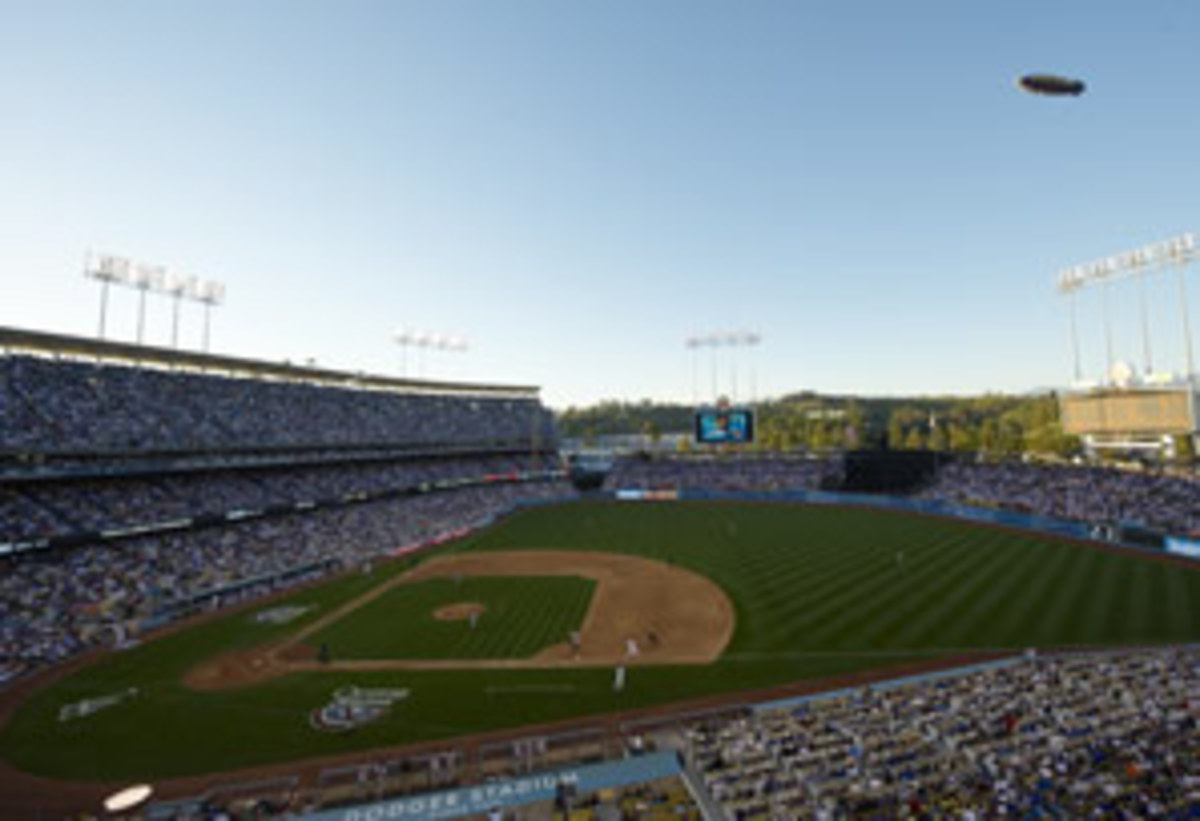Bankrupt Dodgers have several assets that money can't buy
Chapter 11 will help the bankrupt Dodgers protect their assets from creditors, the largest of which -- in every sense of the word -- is Manny Ramirez, who is owed nearly $21 million in retirement. But which of the Dodgers' many assets are most worth protecting, not merely from Manny, but from the self-harming hands of owner Frank McCourt? Before the Dodgers disappear entirely in a pyre of acrimony and alimony, these priceless assets should be rescued from the flames, beginning with:
1. The Dodgers' home uniforms, which are unnaturally white, the white of Chlorox-commercial bed sheets. Against that white, the red numbers on the left rib cage pop like lipstick on a starched collar, as former first baseman Steve Garvey might put it. The script "Dodgers" across the chest is divine, as if God signed it with a blue Sharpie. Yes, the cash-poor Dodgers are metaphorically wearing a barrel, but they can take solace in literally wearing -- with apologies to the Canadiens, Yankees and 1963 Chargers -- the most beautiful uniforms in sports.
2. Dodger Stadium is as pleasant a place as you'll find to spend an evening, especially when the sun is setting, gradually disappearing, like those orange Union 76 balls that slowly vanished from car antennas in the parking lot. With Dodger attendance down 7,000 fans a game, there's no shortage of legroom. The park's a little worn, like L.A. itself, fading beneath that acid-washed sky, but from the blue seats, in the top deck, with a light breeze, you can look out at the pavilion roof zigzagging up and down in perfect imitation of your EKG and it's almost perfect. The heart beats faster still when suddenly, from two rows up, from the planet's last remaining transistor radio, issues the voice of ...
3. Vin Scully, who once told me, "I can't tell you how many times I will stand up in the booth and the anthem is being played and I'm thinking, 'How lucky can I be? How can I possibly be doing this? And for so long?' It really is overwhelming, and my only feeling is this tremendous depth of gratitude to God." After he said that, in a voice like a satin nightie, he sat down at his mic and I stepped outside to watch the game from the top deck, and listened to him leaking from radios, and remained there as the taillights were receding to infinity in the parking lot, thinking: How lucky can I be?
4. Jaime Jarrin, by comparison, is the junior member of Dodger broadcasts in only his 53rd season calling games in Spanish, nine fewer than Scully's 62. But Jarrin has nevertheless been around long enough to be enshrined in Cooperstown, and to see his grandson drafted by the Dodgers three weeks ago. And Jarrin may well be around to call a game with his grandson in big-league Dodger azul. Second baseman Stefan Jarrin was selected in the 40th round, but that's 22 rounds higher than Mike Piazza in 1988, when the catcher was drafted as a courtesy to family friend Tommy Lasorda. Speaking of whom ...
5. The picture of Lasorda on the wall of Chief Karlin's office in Fletch: I'd preserve that as a Dodger keepsake. Seeing the photo, Chevy Chase said to Joe Don Baker: "Hey, you and Tommy Lasorda! I hate Tommy Lasorda." Then he punched the photo of the Dodger skipper, shattering the frame's glass. The scene is emblematic of all those cameos that Dodger stars made in countless films, sitcoms and dramas, as when Don Drysdale and Wes Parker guested on The Brady Bunch, or Leo Durocher encountered Herman in a park on The Munsters, or Steve Garvey deplaned -- de-planed! deplaned! -- on Fantasy Island. The Dodgers were special, like it or not. Lasorda was a frequent guest on The Tonight Show with Johnny Carson. Whereas Frank Quilici, who managed my Twins at the time, was not.
6. Scout Mike Brito, for 20 years, stood behind the screen at Dodger Stadium, directly behind home plate, in a suit and tie and Panama hat, cigar in mouth, a radar gun extended in his right hand like he was holding up a bank with a hair dryer. Brito, more than any other individual, epitomized the Los Angeles Dodgers to me, and not merely because he discovered Fernando Valenzuela, who was and remains the epitome of Los Angeles Dodger players. (Brooklyn is another list of assets entirely.) Unlike anyone on the roster, Brito was always there for two decades, beginning in 1978 and ending in the era of the automatic radar reading. It couldn't have helped that field-level fans don't like their views obscured by a Panama hat, no matter how dapper that hat may be. And while Brito threw out the first pitch at a game this April -- what he hit on the radar gun, alas, went unrecorded -- there ought to be a statue of him behind the plate at Dodger Stadium, in his old spot, in perpetuity, radar gun forever clocking a phantom fastball.
7. Dodger Dogs. Frankly -- and the pun is very much intended -- the Dodger Dog is included here not so much as a culinary institution but as a single-serving rebuke to the Dodgers' All-You-Can-Eat Pavilion. There, Dodger fans can eat all the dogs, nachos, peanuts, popcorn and soda they can pour, stuff or insert into their pieholes, without regard for the consequences of unsustainable gluttony. As a metaphor for the McCourt era of ownership, it's hard to beat the All-You-Can-Eat Pavilion. We'll let Manny take that.






